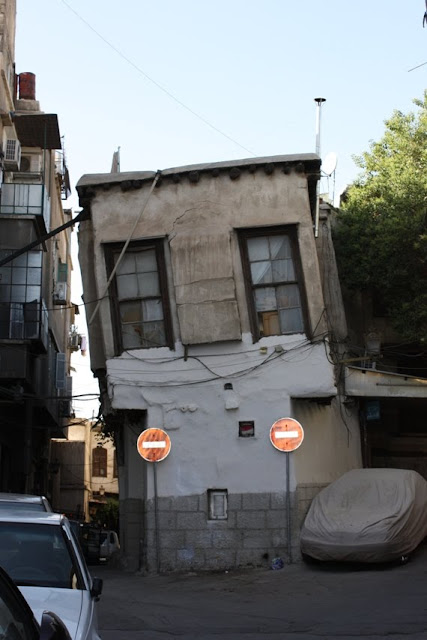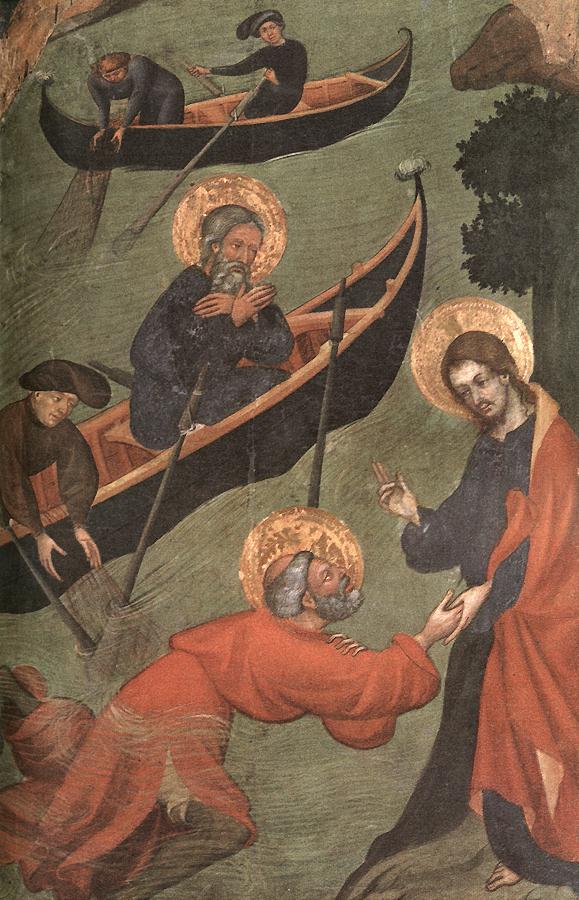Now there was a disciple at Damascus named Ananias. The Lord said to him in a vision, "Ananias." And he said, "Here I am, Lord."
And the Lord said to him, "Rise and go to the street called Straight, and at the house of Judas look for a man of Tarsus named Saul, for behold, he is praying. (Acts 9:10-11)
I had done a little research about Damascus before we left home, and had managed to find references to Straight Street (not hard, as it's the main street of Old Damascus), but no references to the house of Judas.
This is the map we were working from. The darker coloured street running horizontally across the map is Straight Street, although on this map it has three different names, which confused the issue somewhat. Also, you need to tilt the map up from the left side to align it with north at the top. Straight Street really runs more in a north-west to south-east direction.
The street called straight is straighter than the corkscrew, but not as straight as a rainbow. St Luke is careful not to commit himself; he does not say it is the street which is straight, but `the street which is called straight.’ It is the only facetious remark in the Bible, I believe.
(Mark Twain, The Innocents Abroad, 1869).
Which way did St Paul come in?
Jerusalem is about 220 km south-west of Damascus. Although some of the places where Paul is said to have experienced his vision are just west of Damascus, there was a Roman road leading to Bab (Gate) Kissan from the south. This was the gate Paul escaped from on his way out, and this was in the Christian quarter of the city. If you rotate the map a little clockwise, to align north to the top, this shows Bab Kissan to be at the south (near the picture of the aeroplane on the map) - so that's my guess!
Plan of Old Damascus
In the times of St. Paul, Damascus was a Greco-Roman city built according to a rectangular plan, which can be traced back to the geometer Hippodamos of Miletus (5th century B.C.) A sturdy wall, with seven or eight gates, surrounded the city. The two main streets, the Decumanus (also called Via Recta or Straight Street) and the Cardus Maximus, were perpendicular to each other, and crossed the whole city, dividing it into four quarters. Despite the labyrinth of winding alleyways, most too narrow for a car, many points of the original Roman plan still remain.
Straight Street in St Paul's time
Straight Street in St Paul's time extended in a straight line from Bab Jabyeh on the north east to Bab Sharqi in the south east. It was 26 metres wide and 1,570 metres long (to be exact), and on both sides there was a line of covered porticos, flanked by shops. The arch at the intersection of Straight Street and Cardus Maximus would have been there.
Straight Street today
The present road is narrower than the ancient one, and about four metres above its original level. In its widest places, it is wide enough for two cars to pass, with a narrow place either side (you couldn't really call it a footpath) for brave people to walk, preferably sideways. At the intersection of Straight Street and what is now called Al Shallah Lane, the monumental arch has been excavated and rebuilt in 1947, by the Syrian Department of Antiquities.
From the Bab Sharqi gate to the monumental arch, the street is called Sharee al Mustaqueem, which is the Arabic word for "straight"', but it is also known as the Suq et-Tawil, which means "the large market" (although on our map it was called Bab Sharqi Street). The other end of the street is covered by a roof and on our map is called Midhat Pasha Street, as it is the main thoroughfare of the Midhat Pasha Souq, a section of the main Al Hamidiyeh Souq. That only left a central section on our map that was actually called Via Recta, the Latin name for Straight Street. Can you see why I was confused?
Pictures of the Street called Straight
Having finally established that the whole street, not just the bit in the middle, was the original Straight Street, I'd like to show some pictures taken in Straight Street, progressing from Bab Sharqi at the eastern end to the Souq Midhat Pasha at the western end, although some of them may be in the wrong order, and some will be repeated from earlier blogs about Damascus. I was (and still am) completely under the spell of this beautiful city.
Bab Sharqi from the outside.
Bab Sharqi, one of the seven (or eight) ancient city-gates of Damascus, is at the eastern end of the Street Called Straight. It is the only gate to preserve its Roman construction, with a large central arch for horse-drawn vehicles (or cars) and two smaller arches on either side for pedestrians (and bikes). There is a 13th century minaret above the northern arch.
Bab Sharqi from the inside.
Bab Sharqi from a bit further down Straight Street, along with some of the beautiful ancient buildings that line the street.
St Sarkis Armenian Apostolic Church can be seen on your left as you begin to walk down Straight Street from Bab Sharqi.
The Armenian Apostolic Church is the world's oldest National Church and is one of the most ancient Christian communities. Armenia was the first country to adopt Christianity as its official religion in 301 AD. The Armenian Apostolic Church traces its origins to the missions of Apostles Bartholomew and Thaddeus in the 1st century.
Al Khair Palace Hotel, Straight Street is 400 years old and was the first hotel for Silk Road caravans entering Damascus. It then became a carpentry establishment where Muslim, Christian and Jewish families lived and worked. In 1995, it fell into disrepair, and then reopened in 2005 as a hotel.
Bikes are an efficient means of transport in Old Damascus. Helmets are unheard of.
Straight Street, looking back towards Bab Sharqi.
Stand-alone minaret on Straight Street, seen through the window of the restaurant where we had lunch.




























































